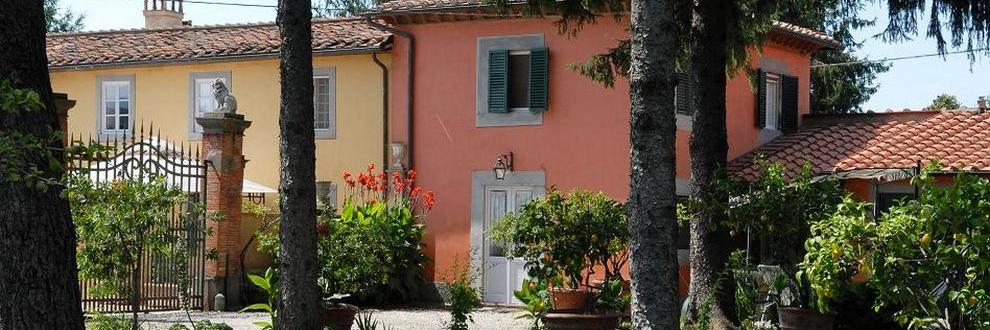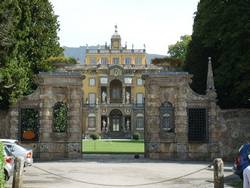
Villa Costa Residenceholiday apartments near Lucca in Tuscany
|
|
Our Accommodations Prices Availability How to find us Places worth visiting Restaurants Practical Tips Houses of Friends Contact Home |
Marlia and Villas
Green rolling hills north of Lucca attracted Lucchese merchants who, having made fortunes on silk trade, started to build here magnificent summer residences as early as the 14th century. Today the number of ville lucchesi exceeds 300, the largest and most beautiful of which fully deserve the status of palaces. In the vicinity of Marlia starts an exquisite trail of the most luxurious villas with fantastic gardens full of fountains, ponds and elegant topiary bushes and hedges. It leads all the way to Camigliano. The history of two of the villas is connected with Poland. (see the map)  Renaissance Villa Oliva, designed by Lucca’s most famous architect Matteo Civitali, boasts the outstanding loggia and beautifully maintained gardens, which are open to visitors. In the 19th century it was owned for some time by a Polish aristocrat Carlo Poniatowski, the relative of King Stanislaw August Poniatowski. Carlo was buried in the chapel on the villa’s grounds.
Renaissance Villa Oliva, designed by Lucca’s most famous architect Matteo Civitali, boasts the outstanding loggia and beautifully maintained gardens, which are open to visitors. In the 19th century it was owned for some time by a Polish aristocrat Carlo Poniatowski, the relative of King Stanislaw August Poniatowski. Carlo was buried in the chapel on the villa’s grounds.Villa Grabau, 16th century residence, is situated nearby in delightful gardens of lemon trees, rare botanical species, and with an impressive orangery. The interior is decorated with frescos and antiques of the period.  The grandest and best-known of them all is Villa Reale, bought by the Orsetti family in the 17th century. It was a rich family of silk merchants, who made a huge fortune in their trade, also setting up a chain of shops in Poland and Lithuania. They redesigned the magnificent park and built the so-called Palazzina dell'Orologio, or "clockhouse". This building has a loggia over the doorway, with a raised section above containing the clock that gives the building its name. Another attraction is the so-called "water theatre" that extends around a large semi-circular pool adorned with statues of gods, water-spewing grotesque masks, terracotta tubs of flowers and a topiary hedge. There is also a “garden theater” formed by yew hedges that surround the stone seats, arranged in a semi-circle. Villa Reale underwent many changes under its next owner, Napoleon’s sister and Lucca’s ruler, Eliza Baciocchi Bonaparte, who set out to transform it in Neoclassical style. Later the property changed owners several times till in 1923 it landed in the hands of the present owners Peci-Blunt counts, who restored the building and the garden.
The grandest and best-known of them all is Villa Reale, bought by the Orsetti family in the 17th century. It was a rich family of silk merchants, who made a huge fortune in their trade, also setting up a chain of shops in Poland and Lithuania. They redesigned the magnificent park and built the so-called Palazzina dell'Orologio, or "clockhouse". This building has a loggia over the doorway, with a raised section above containing the clock that gives the building its name. Another attraction is the so-called "water theatre" that extends around a large semi-circular pool adorned with statues of gods, water-spewing grotesque masks, terracotta tubs of flowers and a topiary hedge. There is also a “garden theater” formed by yew hedges that surround the stone seats, arranged in a semi-circle. Villa Reale underwent many changes under its next owner, Napoleon’s sister and Lucca’s ruler, Eliza Baciocchi Bonaparte, who set out to transform it in Neoclassical style. Later the property changed owners several times till in 1923 it landed in the hands of the present owners Peci-Blunt counts, who restored the building and the garden. Villa Torrigiani with its impressive façade was built in the 16th century by the powerful family Buonvisi. After the homicide of one of the family members and family bankruptcy, the Villa was sold to marquis Santini who transformed the garden, inspired by the splendor of French style. He created a wonderful multi-level Theater of Flora. Since 1816 the Villa has been the property of the Torrigiani family.
Villa Torrigiani with its impressive façade was built in the 16th century by the powerful family Buonvisi. After the homicide of one of the family members and family bankruptcy, the Villa was sold to marquis Santini who transformed the garden, inspired by the splendor of French style. He created a wonderful multi-level Theater of Flora. Since 1816 the Villa has been the property of the Torrigiani family. Villa Mansi in Segromigno in Monte was built in the 16th century and rebuilt repeatedly over the next centuries giving it a unique Baroque look. The time of its greatest splendor was the 17th century when it was owned by the aristocratic family Mansi, who hired Filippo Juvarra to renovate the garden. The whole park was thus transformed by his genius into the perfect scenery with grottos and sculptures, little of which, alas, remain today. |